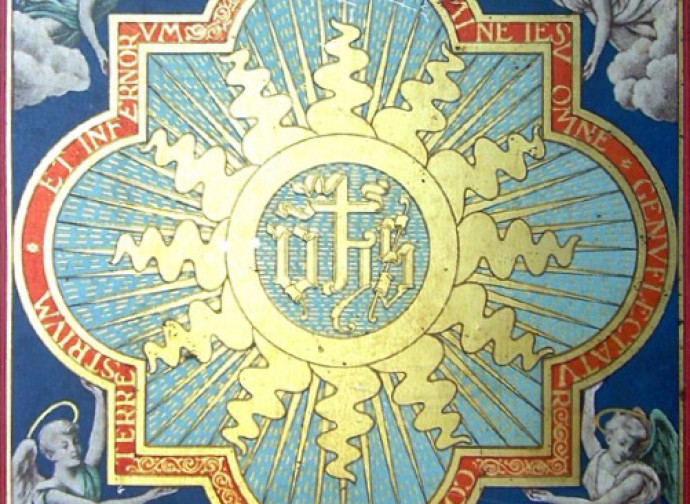Most Holy Name of Jesus
"Whatever you ask in my name, I will do it." The words of Our Lord in John's Gospel stress the importance of the Most Holy Name of Jesus, actually venerated from the earliest centuries of Christianity

"Whatever you ask in my name, I will do it." The words of Our Lord in John's Gospel stress the importance of the Most Holy Name of Jesus, actually venerated from the earliest centuries of Christianity, as attested by the various Christograms (those combinations of Greek or Latin letters of the alphabet to form acronyms of the name of Christ) found in early Christian art. The liturgical cult of the Name of Jesus, however, would only take root between the 15th and 16th centuries.
The sacredness surrounding the name of Jesus, which means "God saves", a name imposed on him by Mary and Joseph after the command they had individually received from the angel, is grafted into God's gradual revelation to Israel unfolding throughout the Old Testament. Here the name seems to be the core of God's pedagogy to make Himself known to men and lead them to Himself. In the theophany of the burning bush (Ex 3: 1-15) the hidden God of the Old Testament reveals Himself as "I am he who I am", thus answering Moses' question of what name he would have to report to the Israelites in order to be obeyed, and so that he could free them from the slavery of Egypt. That name – enclosed in the sacred tetragrammaton YHWH, which many Jews do not pronounce, and expressed by the title of Lord (Adonai) – communicates that "God is the fullness of Being and of every perfection, without origin and without end" (Catechism of the Catholic Church, 213); it also communicates God's faithfulness to His promise, to be fulfilled with Jesus Crucified and expressed in the prophecy pronounced before the Passion: "When you have exalted the Son of man, then you will know that I am" (Jn 8:28).
The mystery linked to the divine name, already the source and object of blessings in the Old Testament, is therefore revealed in the name of Jesus, 'God saves', that is, the God-with-us (Emmanuel. prophesied by Isaiah) born of the Virgin, the Incarnate God who makes himself known to men by revealing His redeeming design up to the cross, thus freeing man from the slavery of sin. The New Testament abounds with passages where the trusting invocation of the name of Jesus is a source of salvation, remission of sins and eternal life. In this name the demons are cast out, the sick healed, and miracles are performed. To give just one example, at the 'Beautiful' door of the temple, Peter, after the Ascension, works the sensational miracle of healing the beggar, a cripple since birth and known by all of Jerusalem for over forty years; this would make the members of the Sanhedrin who persecuted the Church say: "An evident miracle occurred through their work; it has become so well known to all the inhabitants of Jerusalem that we cannot deny it". The episode, to which St. Luke dedicates almost two entire chapters (Acts 3 and 4), began with Peter's words: "In the name of Jesus Christ, the Nazarene, walk!"
The cult of the Most Holy Name of Jesus assumed liturgical importance mainly thanks to Saint Bernardine of Siena (1380-1444), who regarded this devotion as fundamental for the renewal of the Church, since the name of the Saviour evokes every aspect of His life. Thanks to Bernardine, the JHS (or IHS) Christogram, made up of the first two letters and the last of the name of Jesus in Greek, entered the common iconography and became familiar to the faithful, whom he invited to kiss a wooden tablet with the holy inscription engraved on, as if to materialise and imprint his sermons in their memory. Bernardine himself designed the symbol with a sun on a blue background and 12 rays, in which the JHS trigram is inscribed. The meaning of the rays was expressed in a litany: I Refuge of the Penitents; II Banner of combatants; III remedy for our infirmities; IV Comfort of those who suffer; V Glory of those who believe; VI Splendour of the evangelizers; VII Help of the weary soul; VIII Relief of the weak; IX Sigh of the meditators; X Help of supplicants; XI Weakness of the contemplating; XII Glory of the blessed in Heaven.
Bernardine was supported by other Franciscans, including Saint John of Capistrano (1386-1456), who defended the sun symbolism from some critics by explaining its roots in the Old Testament. As in the book of the prophet Malachi: "the Sun of justice will rise with healing in his rays". Pope Martin V decided to endorse the symbol, asking to add a cross surmounting the H; in 1530 Clement VII authorised the Franciscan Order to recite the Office of the Most Holy Name of Jesus; a few years later, the newborn Company of Jesus contributed to spreading this devotion and took the symbol as its emblem with the addition of three nails. In 1721, when the celebration of the Name of Jesus was already widespread in several regions, Innocent XIII extended it to the whole Church. The Commentary to the post-conciliar reform for about three decades led to excluding the celebration from the General Roman Calendar (though not from the liturgical year, as it survived in individual calendars), before its definitive reintroduction in 2002 under John Paul II.
Further reading:
Catechism of the Catholic Church, God reveals his name (par. 203-213)




